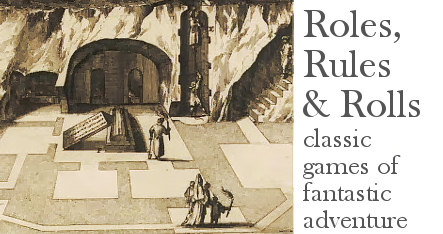This is part of a series of posts with a scene-by-scene critique, appreciation, and improvement of the 1986 TSR module B10, Night's Dark Terror.
Barring any random encounters on the way, the journey from the gnomes' ferry to Rifllian, trade village of the Callari elves, is uneventful. The action once they get there, however, is unusual in an adventure game. Aided by NPCs Stephan and Taras Sukiskyn, the goal is to sell the 24 surviving white horses for the best price possible.
The economic game was more important in older versions of D&D than the present one. Back then, gold translated to experience points -- and ultimately to the grandness of the stronghold your character could build at high levels. The party's cut of the horse sale is not strictly dungeon loot but should absolutely count toward experience in such a system. This balances out the stingy rewards for defeating low-level monsters in Mentzer Basic D&D.
| "Somehow, I don't think those adventurers gave me the best deal..." |
But where's the game in wheeling and dealing? B10 provides a general system for haggling over prices that takes on particular importance in horse sales. The NPC seeking to buy starts at an insulting one-third of the base price. Depending on a 2d6 reaction roll with PC charisma modifier, the NPC in the worst case will only improve their offer to 40%, and in the best case go to 140%.
With these rules, the random element means that it's important to find as many potential buyers as possible. The module gives us that, to some degree. We've already had an encounter with some merchants seeking to buy, and now at Rifllian, even the ferryboat operator is keen to acquire some horseflesh. Stephan, experienced trader that he is, will have some idea of what a good base price is. Between random elves and the less generous but higher-volume buyer Prestelle, the horses should eventually end up unloaded for a better or worse price.
Of course, it's also reasonable for the party to leave the haggling game to the NPCs. It is the Sukiskyns' herd after all. If no party member has a Charisma beating Stephan's 15, there is no reason in-game to do it yourself (and in Moldvay Basic only an 18 Charisma beats his reaction bonus!) In my game, the players opted for more conventional adventuring, leaving the uncle and nephew behind in Rifllian to go investigate news of a hidden slaver stronghold in Kelven.
There are a few more sights and encounters of little importance in the village. The players are likely to find out that Jolenta and her stooges have been asking after them. Once they leave they are also likely to be tracked by agents of the Iron Ring. All this is meant to drag them into the next chapter of the adventure, which as I've said, has already been preepted by my players' initiative.
So then, some concluding remarks, just in case we don't return to the wilds of eastern Karameikos. As an adventure, B10 earns its accolades, as well as the occasional brickbats thrown its way. It's an unfolding series of varied combat challenges, sometimes on the defensive, sometimes on the offensive. We are not in the branch of D&D where Ed Greenwood's example has overbalanced descriptions, so each encounter and location has one or two pithy, meaningful details. More than this, it's emotionally engaging, with plenty of non-player characters at risk of victimization from the goblin raids and Iron Ring plot. This kind of engagement was a strength of the Basic D&D line as it evolved beyond AD&D's increasingly baroque obsessions with tournament-style traps and trickery.
At the same time, this hobby art-form is still finding its legs in 1986. Never more so than when it comes to balancing story, an experience more and more players in those days were demanding, with player agency. This module's predecessor as an initation to Expert-level play, Isle of Dread, had already shown the way for exploration hexcrawls -- an experience that AD&D's dungeon-centered repertoire lacked good examples of. But in B10, you feel the plot elements struggling against the hexcrawl elements, and it takes an active DM intervening for the latter to shine through.
Anyway, we have gotten through the meaty core of B10, the map-and-counters setpiece siege and everything that flows directly from it. Time, and possibly experience, will tell if the final section of the module is any good. If it's anything like the other parts, there is potential, but a good deal of hacking will likely be needed!

